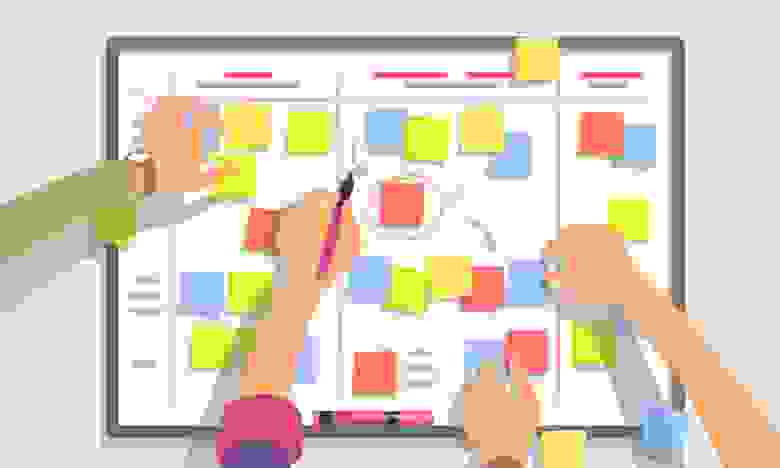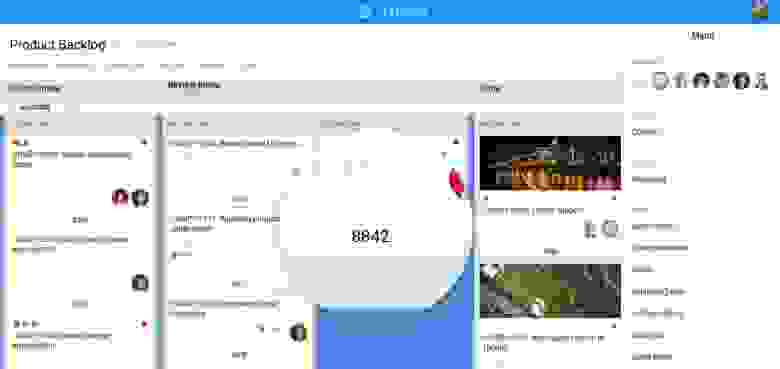Teams that apply popular Agile practices explain why they have chosen this methodology in their own ways. For someone, it seems obvious to work with obligatory and “sacred” Agile; someone can define non-binding or controversial practices. In any case, Agile is one of the most popular methodologies in project management nowadays. Its practices and concepts are appreciated by many developers and managers around the globe.
What are these powerful practices that make Agile popular and trendy? Here we share the list that is definitely incomplete but foundational.

Let's dive into the basic practices project managers should be familiar with. But first, it's quite important to remind why Agile methodology is still beneficial.
Do you still have hesitations about applying Agile methodology into your business? Here're some of the most obvious Agile advantages.
Agile projects that are performed in accordance with any of Agile methods determines its system. With its all ways of planning, administration, testing scenarios, and sprint-formed development, Agile provides the following:
Some decisions within the project may be accompanied by long negotiations and meetings, but not for Agile. In Agile, everyone knows their work time costs and they will not go wasting it. Every step can be made easier and faster.
One of the Agile postulates proclaims that the customer wishes are the highest considerations at all. Agile teaches team members to work more closely with customers to understand their vision of the project and its individual parts better.
Agile includes regular contact with personal discussions, online meetings or video conferences for more lively communication.
Agile methodology was developed to unite employees with each other and work and stick together. Everyone in the Agile team has its own workload for a certain period. Everyone has a responsibility to do everything on time to achieve the best outcomes.
The methodology is instrumental in-group cohesion and vivid professional cooperation.
The result of Agile methodology work is a holistic and functioning product that meets all business goals. All the work done allows the project to be:

Agile teams choose the amount of work possible to be done within a particular time. According to the iterative development, teams may decide themselves what they are able to do based on their capabilities and experience from the previous iteration.
It's a good idea to divide major tasks in a project into the parts, as many of them accumulate, forming a queue. In this case, a product manager needs to work carefully with all backlog tasks, determining the right priorities for each one.
Typically, the product backlog includes the following elements: product features, possible bugs, product knowledge, some technical work, etc.
All items in the backlog are ordered according to their value. The weightier the element, the sooner it will go to work. The top positions will be described in more detail and clear compared to the bottom elements. All of them should be understandable for non-technical team members and stakeholders.

Collaboration with customers is an essential concept of Agile methodology. Agile teams should provide all the info needed to their customers and inform them of the progress. Managers should improve constant communication and it should be a part of internal teamwork.
A user story in Agile management means a unit of work that should be completed in a particular Sprint.
Agile assumes describing the functionality of communication with customers and describing the product’s position in a specific way (there is a simple template: “I want to … because …”).
User stories should contain a general description, acceptance criteria, and time estimation. If product managers see that user stories are too complex, they are able to break the stories up into smaller ones.
There are two essential principles in the Agile methodology:
If you choose Agile methodology, you should have the following roles and groups of professionals in your Agile team:
Your team may also include some extended members for technical or domain expertise.
Scrum meeting and Kanban StandUp are daily short meetings, usually arranged by a product manager or a product owner. This kind of team gathering lasts about 15 minutes and requires the presence of the whole team.
There are 3 basic questions (that can be formulated with variations) that should be discussed within the meeting:

Timeboxing is aimed at solving personal tasks in smaller time frames.
As we know, Sprints last according to the specified timeframes, typically from two weeks to a month. Scrum meetings are also stiff. Their usual length is about 15 minutes. This involves having deliverables and deadlines.
When you are ready with the functionality and can explain how it works to your customers, then it's time for the Sprint demo meeting.
This kind of meeting is rather important because the customers can confirm that they accept all the features proposed and that these features were made in accordance with their requirements and expectations.
Retrospective means the meeting devoted to the final iterative development. All team members are recommended to participate. Customers also often attend this meeting.
During this event, possible improvements, the quality of work, tools used, and other issues are discussed.
Continuous integration means that the code is up to date. All code was created which will be verified before it is connected with the old code. It simplifies the testing of new user stories.
A Burndown chart demonstrates whether all the things really go in accordance with the programming calendar and the entire plan. The chart reflects the work timing and schedule. It also shows the number of user stories per unit of time, below or above your plan.

All sessions begin with writing programming adaptive tests. They are also preceded by unit tests. Then the code specific to the user stories is written.
It is rather important to get information about features that do not work as planned. Tests run automatically before starting work. This ensures that all code changes are acceptable.
In Agile, requirements prioritization is used in to define which specific product requirements should be included in a specific release.
Prioritization also minimizes risks during development as the most important issues are performed first. There are many popular prioritization techniques and frameworks that professional product managers and project managers apply to get all things done.
According to Agile, user stories are implemented in pairs. It involves a primary and secondary developer. So there is one owner of the user story and the other programmer who provides support. The reviews of code are also carried out in pairs.
Product release is a set of new features or the final launch of the product. Competent release planning helps teams to produce quality products.
The secret of successful release management is not just about giving customers access to new features. This is the final date when your team can share new experiences of their work and support interaction with customers.
All stakeholders should be aware of when they can expect new functionality.
This list of Agile practices can be continued and supplemented with other interesting concepts. However, what practices can be used by a non-technical team?
We've found a bright example of using a backlog and prioritization of tasks by the team of the air transport company «Air Methods» that specializes in providing first aid.
The company involves more than 6K employees who are actively working on creating and managing a strategy for learning and development.

At the very beginning, this team was faced with the fact that the stakeholders did not understand how much time and effort it would take to create training projects.
So the team came to the Agile practice of using and managing backlog and prioritization. They started to use Trello to visualize it.
Requests of the stakeholders are collected on the board, the team is assigned a green or red label to each. “Green” projects can be done now, “red” ones are in the queue.
Every month, the team and the stakeholders meet to define new priorities, vote and discuss.
This practice helps to work with business expectations, creates synergy within the team, increases its effectiveness. As a result, the non-technical team began to work more productive in coop with the stakeholders.
Nowadays, available online services and project management tools, the vivid cases of global companies, a variety of modern courses and methodological literature help us to apply Agile's core values and principles painless.
Every day Agile techniques and practices provide success to many companies and attract more and more technical and non-tech teams. Have you already applied to them?
What are these powerful practices that make Agile popular and trendy? Here we share the list that is definitely incomplete but foundational.

Let's dive into the basic practices project managers should be familiar with. But first, it's quite important to remind why Agile methodology is still beneficial.
5 distinguished benefits of Agile methodology on the roll
Do you still have hesitations about applying Agile methodology into your business? Here're some of the most obvious Agile advantages.
1st Benefit: Agile project is more viable
Agile projects that are performed in accordance with any of Agile methods determines its system. With its all ways of planning, administration, testing scenarios, and sprint-formed development, Agile provides the following:
- its easier to control projects during the development and it's more convenient to track weaknesses, implement changes and improve the project structure.
- such projects usually have more balanced functionality and a more elaborate design.
2nd Benefit: Agile means faster decisions
Some decisions within the project may be accompanied by long negotiations and meetings, but not for Agile. In Agile, everyone knows their work time costs and they will not go wasting it. Every step can be made easier and faster.
3rd Benefit: Agile makes customers feel better
One of the Agile postulates proclaims that the customer wishes are the highest considerations at all. Agile teaches team members to work more closely with customers to understand their vision of the project and its individual parts better.
Agile includes regular contact with personal discussions, online meetings or video conferences for more lively communication.
4th Benefit: Agile increases motivation
Agile methodology was developed to unite employees with each other and work and stick together. Everyone in the Agile team has its own workload for a certain period. Everyone has a responsibility to do everything on time to achieve the best outcomes.
The methodology is instrumental in-group cohesion and vivid professional cooperation.
5th Benefit: Agile helps to achieve real business success
The result of Agile methodology work is a holistic and functioning product that meets all business goals. All the work done allows the project to be:
- easy-adaptable to the changes and trends
- competitive, developed with the most necessary functionality
- easy-maintained and supported

The list of basic Agile practices
Iterations
Agile teams choose the amount of work possible to be done within a particular time. According to the iterative development, teams may decide themselves what they are able to do based on their capabilities and experience from the previous iteration.
Product backlog and tasks queue
It's a good idea to divide major tasks in a project into the parts, as many of them accumulate, forming a queue. In this case, a product manager needs to work carefully with all backlog tasks, determining the right priorities for each one.
Typically, the product backlog includes the following elements: product features, possible bugs, product knowledge, some technical work, etc.
All items in the backlog are ordered according to their value. The weightier the element, the sooner it will go to work. The top positions will be described in more detail and clear compared to the bottom elements. All of them should be understandable for non-technical team members and stakeholders.

Focus on customers
Collaboration with customers is an essential concept of Agile methodology. Agile teams should provide all the info needed to their customers and inform them of the progress. Managers should improve constant communication and it should be a part of internal teamwork.
User stories
A user story in Agile management means a unit of work that should be completed in a particular Sprint.
Agile assumes describing the functionality of communication with customers and describing the product’s position in a specific way (there is a simple template: “I want to … because …”).
User stories should contain a general description, acceptance criteria, and time estimation. If product managers see that user stories are too complex, they are able to break the stories up into smaller ones.
Value stream analysis
There are two essential principles in the Agile methodology:
- Defining the product based on user stories, which are based on business analysis.
- Defining dependencies between the business and technical functionality.
Agile roles
If you choose Agile methodology, you should have the following roles and groups of professionals in your Agile team:
- Team Lead, Project Lead, and Scrum Master
- Stakeholders
- Product Owner for Scrum and On-site customer for XP
- Team members
Your team may also include some extended members for technical or domain expertise.
Daily meetings
Scrum meeting and Kanban StandUp are daily short meetings, usually arranged by a product manager or a product owner. This kind of team gathering lasts about 15 minutes and requires the presence of the whole team.
There are 3 basic questions (that can be formulated with variations) that should be discussed within the meeting:
- what was done yesterday?
- what are the current goals?
- are there any obstacles?

Timeboxing
Timeboxing is aimed at solving personal tasks in smaller time frames.
As we know, Sprints last according to the specified timeframes, typically from two weeks to a month. Scrum meetings are also stiff. Their usual length is about 15 minutes. This involves having deliverables and deadlines.
Sprint demo meeting
When you are ready with the functionality and can explain how it works to your customers, then it's time for the Sprint demo meeting.
This kind of meeting is rather important because the customers can confirm that they accept all the features proposed and that these features were made in accordance with their requirements and expectations.
Retrospective meeting
Retrospective means the meeting devoted to the final iterative development. All team members are recommended to participate. Customers also often attend this meeting.
During this event, possible improvements, the quality of work, tools used, and other issues are discussed.
Integration
Continuous integration means that the code is up to date. All code was created which will be verified before it is connected with the old code. It simplifies the testing of new user stories.
Burndown chart
A Burndown chart demonstrates whether all the things really go in accordance with the programming calendar and the entire plan. The chart reflects the work timing and schedule. It also shows the number of user stories per unit of time, below or above your plan.

Test-driven development
All sessions begin with writing programming adaptive tests. They are also preceded by unit tests. Then the code specific to the user stories is written.
Automated tests
It is rather important to get information about features that do not work as planned. Tests run automatically before starting work. This ensures that all code changes are acceptable.
Prioritization of requirements
In Agile, requirements prioritization is used in to define which specific product requirements should be included in a specific release.
Prioritization also minimizes risks during development as the most important issues are performed first. There are many popular prioritization techniques and frameworks that professional product managers and project managers apply to get all things done.
In-pairs programming
According to Agile, user stories are implemented in pairs. It involves a primary and secondary developer. So there is one owner of the user story and the other programmer who provides support. The reviews of code are also carried out in pairs.
Release planning
Product release is a set of new features or the final launch of the product. Competent release planning helps teams to produce quality products.
The secret of successful release management is not just about giving customers access to new features. This is the final date when your team can share new experiences of their work and support interaction with customers.
All stakeholders should be aware of when they can expect new functionality.
This list of Agile practices can be continued and supplemented with other interesting concepts. However, what practices can be used by a non-technical team?
We've found a bright example of using a backlog and prioritization of tasks by the team of the air transport company «Air Methods» that specializes in providing first aid.
The company involves more than 6K employees who are actively working on creating and managing a strategy for learning and development.

At the very beginning, this team was faced with the fact that the stakeholders did not understand how much time and effort it would take to create training projects.
So the team came to the Agile practice of using and managing backlog and prioritization. They started to use Trello to visualize it.
Requests of the stakeholders are collected on the board, the team is assigned a green or red label to each. “Green” projects can be done now, “red” ones are in the queue.
Every month, the team and the stakeholders meet to define new priorities, vote and discuss.
This practice helps to work with business expectations, creates synergy within the team, increases its effectiveness. As a result, the non-technical team began to work more productive in coop with the stakeholders.
Conclusion
Nowadays, available online services and project management tools, the vivid cases of global companies, a variety of modern courses and methodological literature help us to apply Agile's core values and principles painless.
Every day Agile techniques and practices provide success to many companies and attract more and more technical and non-tech teams. Have you already applied to them?